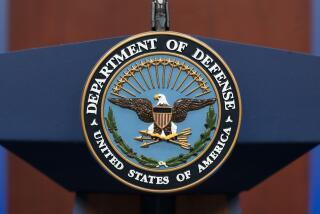Return Engagement in a Desert Theater
KUWAIT CITY â In the northern desert, where the temperature recently soared to 150--yes, 150--degrees Fahrenheit for four days in a row, U.S. soldiers traded tall tales of poisonous lizards and an afternoon sandstorm obscured a landscape where 155-millimeter guns peeked from camouflage netting.
Spc. Allen Scott of the 1st Cavalryâs 82nd Field Artillery Regiment contemplated his third tour of duty in Kuwait since the 1991 Persian Gulf War. For U.S. soldiers, he said, Kuwait is getting to be one of the Armyâs routine duty stops, just like South Korea and Germany.
Since the Gulf War, U.S. protection of its interests in the regionâs oil fields has meant stationing the 5th Fleet in the Gulf, ground forces in Kuwait and Air Force personnel at bases in Saudi Arabia.
With the addition of more than 3,000 American soldiers to Kuwait last week after Iraqi President Saddam Hussein mounted a military operation in northern Iraq, U.S. forces in the region now exceed 30,000.
Kuwaiti and U.S. officials said the buildup was only prudent because of Husseinâs unpredictability. But will Kuwait and the other Gulf Arab states be able to present a deterrent to Hussein in their own right in the foreseeable future?
According to a Western diplomat familiar with the emirateâs defenses, Kuwait will not be able to go it alone for at least the next five years. But it has already made significant strides in improving its security and helping to safeguard the strategically vital petroleum reserves beneath its sands and in neighboring Saudi Arabia.
*
âWe have tried to buy the best weapons in the world and get the best people to train us,â Kuwaitâs defense minister, Sheik Ahmed al Hamoud al Sabah, told reporters Wednesday.
At its liberation from Iraqi occupation in 1991, the Kuwaiti army was left virtually without equipment. Since then, the government has embarked on a $12-billion defense buildup, buying the most sophisticated weapons available from the United States and Europe.
Kuwaitâs order of more than 200 Abrams tanks--far superior to the decades-old Soviet-designed armor in the Iraqi arsenal--will make it one of the worldâs strongest tank powers. But fewer than half have been delivered, and training of crews has just begun.
Kuwait has also taken other steps to enhance its security: It constructed a trench 5 yards wide and 3 yards deep along its 130-mile frontier with Iraq, and announced plans Wednesday for an electrified border fence and a system of lookouts. It also has raised a spy blimp that peers into Iraq 24 hours a day.
âThey . . . recognize that over the long run there has got to be a credible self-defense capability, but it is a long process,â said a Western diplomat in Kuwait.
The long-term goal is to turn Kuwait, with a population of 1.7 million--of whom more than half are not citizens but foreign workers--into a disproportionately strong military power augmented by defense pacts with Saudi Arabia and the other smaller Gulf states.
The U.S. and Western forces hope to become the last line of defense one day. But until then, the Americans are expected to make regular return visits.
âI think weâll be around for a long time and weâll have to keep coming back,â said 21-year-old Spc. Johnny Mendoza of Porterville, near Fresno. âWe canât afford to let anyone else come in here and take the oil.â
(BEGIN TEXT OF INFOBOX / INFOGRAPHIC)
U.S. in Kuwait
In addition to 1,200 troops scattered around Kuwait, the United States has personnel and equipment stationed in the following areas:
*
Daniszewski was recently on assignment in Kuwait City.
More to Read
Sign up for Essential California
The most important California stories and recommendations in your inbox every morning.
You may occasionally receive promotional content from the Los Angeles Times.










